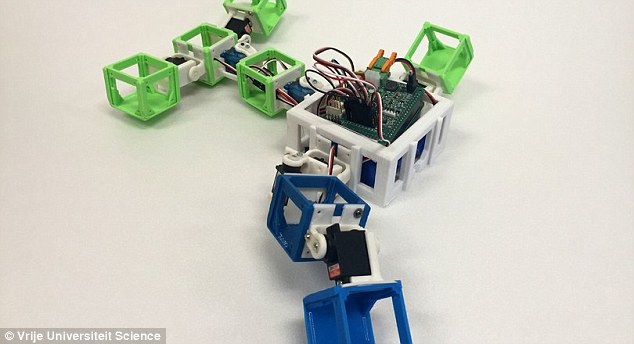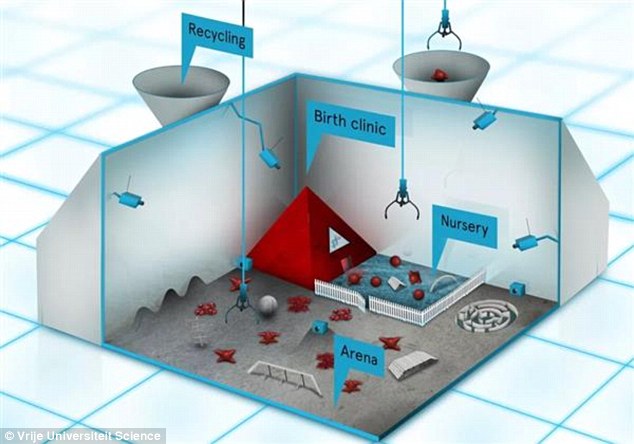

What if robots could evolve?
It's the question asked by a group of scientists in Amsterdam, whose radical new project aims to create smarter, more advanced robots through a process similar to sexual reproduction.
While the idea may sound far-fetched, they've already demonstrated a proof of concept – in February, two robot parents came together to 'mate,' and the first 'robot baby' was born.

What if robots could evolve? It's the question asked by a group of scientists in Amsterdam, whose radical new project aims to create smarter, more advanced robots through a process similar to sexual reproduction. On the right, the two parent robots can be seen near their 'baby,' which is pictured left
In the Robot Baby Project at Vrije Universiteit Amsterdam, scientists have developed a way for robots to have 'sex' and pass on their DNA to offspring.
Doing this can allow them to 'develop their bodies through evolution,' making for successive generations that have more advanced physical and behavioural capabilities.
As the process continues, the researchers say robots can become more suitable for use in unknown environments that could be hazardous to humans, like deep sea mines or even other planets.
'We have two robots that meet and mate, and just as in the animal kingdom, this results in a baby,' says Guszti Eiben, Professor of Artificial Intelligence at VU, in a video explaining the concept.
The robots live, work, and reproduce in an 'Arena,' where they are able to select a suitable mating partner.
They learn through motivation, the researchers explain, and in this case, they are motivated to walk toward a red light.
When the two robots come together, they are then able to communicate and even mate.
'When they evaluate each other favourably, they send their genomes through the Wi-Fi network,' says Milan Jelisavcic, a PhD student at the university.
'A sexual reproduction mechanism then creates the new genome. Code of this genome is sent to the 3D printer then, for printing new components.'
During a year-and-a-half development period, the researchers were able to achieve the implementation of a full life cycle.
When the parent robots 'reproduce,' their features are randomly recombined.
This includes the brain – software – and the hardware.

Scientists have developed a way for robots to have 'sex' and pass on their DNA to offspring. Doing this can allow them to 'develop their bodies through evolution,' making for successive generations that have more advanced physical and behavioural capabilities. Parent robots are pictured above
'With evolutionary techniques, we evolve the neural networks of the robots,' explains Jacqueline Heinerman, PhD student at VU, in the video.
These neural networks are responsible for their behaviours.
The lab also contains a 'Birth Clinic' and a 'Nursery' for the robotic child, and once born, each must undergo a learning process.
If it is deemed satisfactory, the child then becomes an adult, and potentially, a parent.
Researchers say this marks the start of a new era – the Industrial Evolution.
In this state, machines could autonomously operate and reproduce.

A sexual reproduction mechanism then creates the genome for the offspring, randomly combining the features from the parents, including software (the brain) and hardware. This can be seen in the 'robot baby' above, which has both blue and green parts

The robots live, work, and reproduce in an 'Arena,' where they are able to select a suitable mating partner. The lab also contains a 'Birth Clinic' and a 'Nursery' for the robotic child, and once born, each must undergo a learning process. If it is deemed satisfactory, the child then becomes an adult, and potentially, a parent
'Evolution is a great designer,' says Eiben.
'The Evolution of Things is an emerging new technology that exploits the power of selection and reproduction to breed robot designs that are hard to obtain by traditional approaches. Robots that evolve can adapt to their environment and cope with unforeseen situations.
'The bodies, brains, and behaviours are continually tested by the environment and the useful traits are amplified in future generations. This technology opens new perspectives for robotics, artificial intelligence, space research, and even biology.'
The researchers unveiled the first robot baby on May 26 at Campus Party in the Jaarbeurs in Utrecht, demonstrating their novel method of 'robot mating.'
One day, they say, this new form of evolution could even play a critical role in the colonization of Mars.
'What does it all mean? It means a proof of concept,' Eiben explains in the video.
'And the concept we prove is the evolution of robots and physical hardware. For science this means that artificial evolution can break out of computer simulations and enter the real world.'

While the idea may sound far-fetched, they've already demonstrated a proof of concept – in February, two robot parents came together to 'mate,' and the first 'robot baby' was born. Robot parent can be seen interacting in the photo above
Day|Week

 China's first intelligent security robot debuts in Chongqing
China's first intelligent security robot debuts in Chongqing A Total of 3,552 Subscribers Vanish In Two Days; YouTube Closes All Doors to Users’ Inquiries
A Total of 3,552 Subscribers Vanish In Two Days; YouTube Closes All Doors to Users’ Inquiries Out of this world! Futuristic UFO-shaped yacht has its own garden and a stunning underwater viewing deck
Out of this world! Futuristic UFO-shaped yacht has its own garden and a stunning underwater viewing deck An old tea house in Chengdu
An old tea house in Chengdu Furious Customer Crushes All the Buns from Vendor Just Because He Was Given the Wrong Flavor
Furious Customer Crushes All the Buns from Vendor Just Because He Was Given the Wrong Flavor 20 post-90s couples hold ’naked marriage‘ in E. China
20 post-90s couples hold ’naked marriage‘ in E. China Female official wearing traditional Han costume to promote local tourism
Female official wearing traditional Han costume to promote local tourism Over 12,000 Runners Seek Medical Care in S China’s Marathon
Over 12,000 Runners Seek Medical Care in S China’s Marathon Six Luxury Sports Cars Totaled after Fail Attempts to Cross China’s Most Perilous Highway Linking SW China’s Sichuan and Tibet
Six Luxury Sports Cars Totaled after Fail Attempts to Cross China’s Most Perilous Highway Linking SW China’s Sichuan and Tibet Incredible Transformation: “Witch Child”Whose Parents Left Him for Dead in Nigerian Makes Speedy Recovery
Incredible Transformation: “Witch Child”Whose Parents Left Him for Dead in Nigerian Makes Speedy Recovery